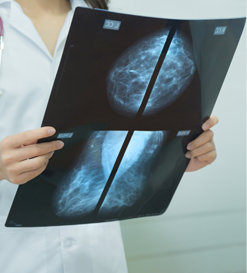Breast lipoma – causes, symptoms, treatment

What are breast cysts and how do they look like?
A cyst is a lump filled with liquid. Cysts are benign and are not a breast cancer risk factor. Although the causes cyst formation are not fully known, it is generally agreed that they result from hormonal disorders (activity of sex hormones, mainly oestrogen) which cause a sectional expansion of lactiferous ducts in the breast and formation of a nodule, i.e. cyst. Cysts are most often diagnosed in young women of reproductive age and in elderly women, who have a higher risk of developing breast cysts.
If you feel any lumps during breast self-examination, it does not necessarily mean that you have breast cancer. Most lesions are benign and can be cysts. Nevertheless, you should visit a specialist physician (gynecologist and/or oncologist). It is good to know how to distinguish cysts from breast cancer, what their causes are, and how they are treated.
Three terms are worth exploring when talking about cysts; namely, simple cyst, complex cyst and fibroadenoma.
A simple cyst does not require biopsy, i.e. invasive diagnostics. It does not require any treatment and requires no more than regular observation on the part of the physician.
A complex cyst is a focal lesion visible on an ultrasound, i.e. a lump or a cyst is filled with a thick, non-homogenous fluid, or surrounded by a thick wall. A complex cyst requires further diagnostics, e.g. biopsy, to exclude any cancerous changes.
Fibroadenomas are the most common benign breast tumours. They are observed in young women and form as a result of hormonal activity of the ovaries. The tumours are visible on a breast ultrasound, hard to touch and may move when pressed by fingers. Women with fibroadenomas may feel a general or stabbing pain in their breast, but sometimes the tumours may be asymptomatic. while the risk that a fibroadenoma becomes malignant is low, experts recommend needle biopsy as well as regular examination of the cyst.
Breast cysts – diagnosis
When you feel a nodule in your breast during self-examination, visit a gynaecologist and/or oncologist. The physician will perform breast palpation followed by an ultrasound and/or mammography. In case of a simple cyst, the cyst is only observed at regular intervals. Since the formation of a cyst is associated with hormonal disorders, in some cases the physician may order hormonal diagnostics (testing the prolactin level in the blood). A fine needle biopsy may be performed in subsequent stage of testing.
Breast cysts – treatment
Surgical removal of breast cysts is recommended in the following situations:
Zostaw swój numer, oddzwonimy i odpowiemy na Twoje pytania
I consent to the use of telecommunication end devices by BRASTER S.A. for commercial purposes and direct marketing, pursuant to Article 172 of the Act of July 16, 2004 – Telecommunications Law and the Act of July 18, 2002 on electronic provision of services. In particular, I consent to receiving incoming phone calls from BRASTER S.A. I declare that I have been informed that the above consent is voluntary and may be revoked at any time.
Strona http://braster.eu/nl realizuje sprzedaż jedynie na terenie Holandii. Jeżeli chcesz zrealizować zamówienie na terenie Polski przejdź na http://braster.eu/pl
I consent to the use of telecommunication end devices by BRASTER S.A. for commercial purposes and direct marketing, pursuant to Article 172 of the Act of July 16, 2004 – Telecommunications Law and the Act of July 18, 2002 on electronic provision of services. In particular, I consent to receiving incoming phone calls from BRASTER S.A. I declare that I have been informed that the above consent is voluntary and may be revoked at any time.
Your message was sent.
We will reply as soon as possible.
Raty PayU to możliwość zapłacenia za zakupy w ratach (od 3 do nawet 36)
Sign In
Create New Account